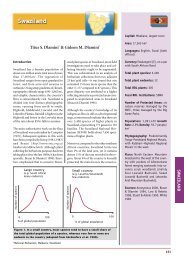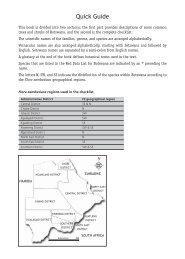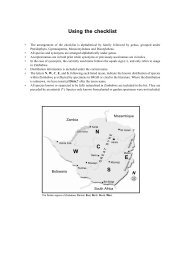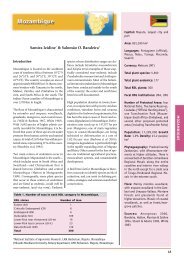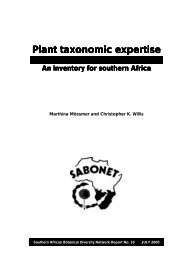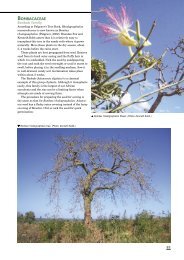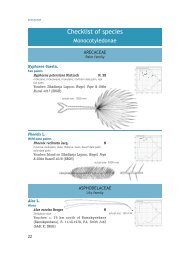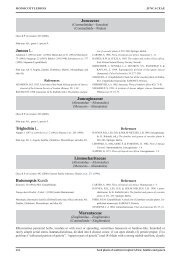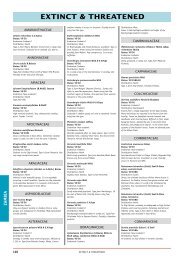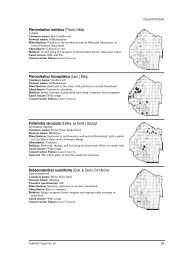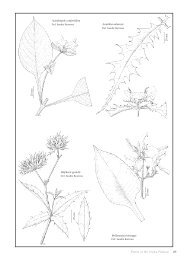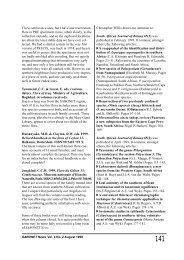266-299 - SABONET
266-299 - SABONET
266-299 - SABONET
Create successful ePaper yourself
Turn your PDF publications into a flip-book with our unique Google optimized e-Paper software.
SIMAROUBACEAE<br />
Selago thyrsoidea Baker var. thyrsoidea <br />
Selago nyikensis Rolfe; Selago thyrsoidea Baker var. nyikensis (Rolfe) Brenan<br />
Suffrutex with several tufted stems 0.2–1 m tall, from a woody rootstock;<br />
leaves sharply ascending, more or less fascicled, linear to oblanceolate, apex<br />
acute, margin entire; flowers in few-flowered racemes, pale to deep violetblue,<br />
bracts oblong-lanceolate, hairy; in montane grassland, often among<br />
rocks; 2,100–2,450 m. A near-endemic, known only from the Nyika Pla-<br />
Brucea antidysenterica J.F.Mill <br />
Trichilia siderotricha Chiov.<br />
Small, sparsely-branched tree to 6 m tall, twigs with prominent leaf-scars<br />
and golden-brown hairs; leaves alternate, imparipinnate, with 3–5 pairs of<br />
leaflets, leaflets hairy above and below, margins wavy; flowers in small<br />
clusters widely spaced along an axillary spike; fruit in clusters, red; in<br />
*Physalis peruviana L. <br />
Cape gooseberry; Chichewa: ntongo, jamu<br />
Perennial herb or shrublet to 0.9 m; leaves more or less opposite, ovatetriangular,<br />
ca 100 x 60 mm, softly hairy, very shallowly toothed or lobed,<br />
petiole to 25 mm; flowers solitary, axillary, conical, mustard yellow; fruit a<br />
greenish to yellow berry completely enclosed by a papery calyx to 30 mm<br />
long; a weed of disturbed areas, roadsides, and fallow land, sometimes<br />
cultivated. A native of S. America, now widespread in much of Africa. The<br />
ripe fruit is edible, tasty, and often used to make jam or a stewed dessert.<br />
Source. Banda & Morris (1986: 57).<br />
Malawi. Nyika National Park, without locality or collecting details (Mill<br />
1979).<br />
Solanum aculeatissimum Jacq.<br />
Shrub to ca 1.5 m tall, stems densely hairy and bearing many straight spines<br />
to 12 mm long; leaves ca 180 x 160 mm, deeply lobed, hairy and bearing<br />
slender spines to 15 mm long; flowers white, ca 16 x 30 mm, peduncle<br />
0.5 mm long, pedicels ca 11 mm long; fruit round, pale yellow or whitish,<br />
streaked green, ca 35 mm diameter; in forest clearings and disturbed areas,<br />
often associated with pine plantations. Widespread throughout Africa; also<br />
in Brazil. Thought possibly to have been introduced to Africa several hundred<br />
years ago.<br />
Source. Bukenya & Carasco (1995: 51).<br />
Malawi. Nyika National Park, without locality or collecting details (Mill<br />
1979); road to Domwe Viewpoint, 2000, Salubeni & Mwanyambo 6794<br />
(MAL); road to Juniper Forest, 7,800’, 1975, Pawek 9949 (White et al. 2001:<br />
553).<br />
Zambia. Nyika National Park, Manyenjere, Kasoma, and Chowo Forests<br />
(Dowsett-Lemaire 1985: 323).<br />
Solanum anguivi Lam.<br />
Solanum indicum auctt., non L.<br />
Perennial shrub 2–5 m tall, stems with stellate hairs and some almost conical<br />
prickles; leaves elliptic-ovate, 100–200 x 50–100 mm, hairy, with or<br />
without a few prickles, sinuate to shallowly lobed, base truncate to cordate;<br />
flowers white, ca 10 x 10 mm; fruit small, round, in clusters, shiny,<br />
orange or red when ripe; in montane forest, secondary montane scrub,<br />
disturbed areas in shade. Widespread in Africa; also in Madagascar and<br />
India. Grown in tropical Africa for its fruit. Some authors have recognized<br />
a number of subspecies.<br />
Source. Brummitt (1973); Bukenya & Carasco (1995: 54).<br />
Malawi. Nyika National Park, forest 4 km W. of Nganda, 1972, Brummitt<br />
& Synge 74 (K, MAL, SRGH, FHO, EA); road to Domwe, 2000, Winter<br />
4084 (MAL, PRE); Mpopoti Hill, 2000, Salubeni & Mwanyambo 6787<br />
(MAL).<br />
*Solanum mammosum L.<br />
Shrub to 1.5 m tall, stems densely hairy, with slightly recurved prickles<br />
5 mm long; leaves ca 110 x 90 mm, lobed to about half the width of the<br />
272 Plants of the Nyika Plateau<br />
SIMAROUBACEAE<br />
SOLANACEAE<br />
teau and the Mafinga Hills.<br />
Source. Flora zambesiaca 8(2): 171 (1990); Hilliard (1999: 222).<br />
Malawi. Nyika Plateau, 7,000’, 1896, Whyte 144 (K, holo.); road from<br />
Chelinda to Kasaramba, just past Chelinda Bridge turning, 2,410 m, 1970,<br />
Brummitt 10721 (K); Chelinda Falls, 1981, Salubeni 3061 (E, MO, SRGH);<br />
Chelinda Bridge, 2000, Mwanyambo 538 (MAL).<br />
Zambia. Nyika, without locality, 1966, Fanshawe 9735 (K, SRGH).<br />
understorey of montane rainforest; 1,400–2,200 m. Malawi and Zambia<br />
northwards to W. Africa and Ethiopia. Rare on Nyika.<br />
Source. Flora zambesiaca 2(1): 212 (1960); Dowsett-Lemaire (1985: 390).<br />
Malawi. Nyika Plateau, Kasyaula and Zovochipolo Forests (Dowsett-Lemaire<br />
1985).<br />
Zambia. Nyika Plateau, Kasoma Forest (Dowsett-Lemaire 1985).<br />
leaf, hairy on both sides, with prickles on midrib and veins; flowers ca<br />
12 mm long, violet to blue; fruit to 50 mm wide, ?yellow, bearing a terminal<br />
‘nipple’; in disturbed habitats or cultivated. Native to the Caribbean<br />
region, cultivated as a medicine or as a cockroach poison. Poisonous if<br />
eaten.<br />
Source. Bukenya & Carasco (1995: 51).<br />
Malawi. Nyika National Park, without locality or collecting details (Patel<br />
1999).<br />
*Solanum nigrum L. <br />
Solanum guineense (L.) Lam.; Solanum suffruticosum Schousb. ex Willd.<br />
black nightshade; Chichewa: mnadzi; Yao: mnesi; Tumbuka: msaka,<br />
musaka<br />
Erect branched annual herb 0.6–1 m tall, completely without prickles; leaves<br />
alternate, ovate-elliptic, margin entire or lobed, glabrous; flowers stellate,<br />
8–18 mm diameter, white with yellow centre; fruit round, purplish to black<br />
when ripe, peduncles erect to spreading, pedicels much shorter than the<br />
peduncles, recurved; a weedy plant of disturbed areas. Regarded as indigenous<br />
to Eurasia, but possibly also natural in Africa. The leaves are cooked<br />
as ndiwo (a vegetable); the ripe berries are eaten, but the green berries are<br />
regarded as poisonous.<br />
Source. Bukenya & Carasco (1995: 46).<br />
Malawi. Nyika National Park, without locality or collecting details (Mill<br />
1979); Chelinda Bridge, 2000, Salubeni & Mwanyambo 6773 (MAL).<br />
Solanum panduriforme E.Mey.<br />
apple of Sodom, bitter apple; Chichewa: nthula, mathika, ntunduwele;<br />
Yao: ntungwisa<br />
Spiny perennial shrubby herb to 1.2 m; leaves simple, alternate, to 125 x<br />
60 mm, oblong-lanceolate, sinuate, undersurface densely hairy, few spines<br />
along midrib below; flowers cup-shaped, lilac to purple; fruit a yellow or<br />
orange berry to 70 mm diameter, poisonous; a weed, often an indicator of<br />
overgrazing, in disturbed areas, roadsides. Eastern and Central Africa; also<br />
in Arabia and India. Roots used to treat boils; the fruit is also used medicinally,<br />
used to cure mange on dogs.<br />
Source. J. Williamson (1975: 216); Banda & Morris (1986: 142).<br />
Malawi. Nyika National Park, without locality or collecting details (Mill<br />
1979).<br />
Solanum schumannianum Dammer<br />
Solanum ulugurense Dammer; Solanum subulatum C.H.Wright<br />
Shrub or small tree to 4 m tall, stems unarmed, but usually with bristly<br />
hairs; leaves to 140 x 50 mm, lanceolate-elliptic, acute to acuminate, entire,<br />
undersurface more or less hairless; flowers white, fruit ca 10 mm diameter;<br />
in light shade in forest or on forest margins. Malawi, Tanzania,<br />
and Kenya.<br />
Source. White et al. (2001: 554).<br />
Malawi. Nyika Plateau, Zovochipolo, without collecting details (Dowsett-<br />
Lemaire 1985: 335).



